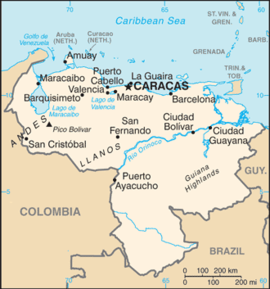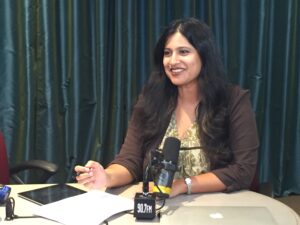Venezuela’s Election In The Crosshairs Of New U.S. Regime Change Scheme

Venezuela – Source: wikipedia.org
03-15-2024 ~ As Venezuela prepares to head to the polls in July, the U.S. has already started drumming up suspicion and doubt around the electoral process.
Twenty-five years after Hugo Chávez took office and began the Bolivarian Revolution in Venezuela, U.S. officials have still not tired of dreaming up new plots to overthrow the country’s government. Five years ago, following the last presidential election, they attempted to install Juan Guaidó—a politician most Venezuelans had never even heard of—as the country’s head of state. And now, with the date for the next presidential election officially set for July 28, the Biden administration is gearing up for the biggest regime-change push since the Guaidó coup attempt.
Venezuela has long been a target for U.S. intervention because of its efforts to build an alternative model to the neoliberal capitalism pushed by institutions like the IMF and World Bank. First theorized and implemented under the leadership of Chávez, the Bolivarian Revolution in Venezuela puts forward a new model that emphasizes using the country’s resources, such as its oil revenue, to fund crucial missions. These then guarantee rights such as education, food, housing, transportation, culture, and sports to historically excluded majorities, to decrease longstanding socioeconomic inequality. A central part of the Bolivarian Revolution is the political and cultural transformation of the people through the promotion of Venezuelan national culture, internationalism, anti-imperialism, and the empowerment of all people as political subjects with rights and responsibilities. It is a project in direct contradiction to U.S. interests in the oil-rich country and the region Washington considers its backyard.
The 2024 Elections
President Nicolás Maduro is running for re-election as the candidate of the United Socialist Party of Venezuela (PSUV) and the broader Great Patriotic Pole coalition. He has built his campaign around a program referred to as the “Seven Transformations,” proposing major new initiatives in the fields of economic modernization, asserting national sovereignty, safety and security, ensuring social rights, political participation, the environment, and geopolitics. These aim to maintain the pro-poor, socialist orientation of the country’s development model while enacting reforms to stimulate greater economic activity and counteract the impact of crippling U.S. sanctions.
The opposition is divided into several different camps. The largest coalition of opposition parties is called the Unitary Platform and consists of parties or factions of parties controlled by the Venezuelan elite who were displaced from positions of power as a result of the Bolivarian Revolution. The Unitary Platform has taken part in several rounds of negotiations with the government over the past year leading up to the elections and signed an agreement last October known as the “Barbados Agreement.”
In this agreement, the opposition was granted concessions on issues related to the organization of the electoral process, and in exchange, the United States agreed to loosen some sanctions relating to Venezuela’s oil and mining industries. The Barbados Agreement stipulated that only opposition figures who are eligible according to existing laws would be permitted to run. At this stage, the Unitary Platform has not chosen a candidate.
The specifics of how the electoral process will be carried out, regulations on campaigning on media platforms, participation of electoral observers, and the updating of electoral rolls were outlined in an agreement signed on February 28. The agreement was the product of dialogue among over 150 political and social organizations and was based on over 500 proposals. Ninety-seven percent of the political parties registered with the National Electoral Council participated.
Nonetheless, U.S. officials have presented this electoral process, subject to such extensive deliberation and approved with such wide support, as an attack on democracy.
María Corina Machado and the Fraud Narrative
The approach of the U.S. government follows a familiar script—wage a campaign in the media and through international organizations to cast doubt on the integrity of the electoral process so relentlessly that the result can be presented as fraudulent no matter what the actual evidence is on election day.
The key piece of the “electoral fraud” narrative is already in place and revolves around the disqualification of the opposition figure María Corina Machado.
Machado is the oldest daughter of Henrique Machado Zuloaga, who was an executive of Sivensa. One of Venezuela’s largest steel companies, Sivensa was nationalized in 2008 under Hugo Chávez. Since the start of the Bolivarian Revolution, Machado has been active in the right-wing opposition and has gone so far as to support destabilization campaigns and attempts to overthrow Venezuela’s democratically elected governments. She served as a member of Venezuela’s National Assembly from 2011-2014.
In July 2015, the Venezuelan comptroller general’s office announced that Machado was barred from holding public office for a period of one year after neglecting to disclose the extent of her earnings while she held public office.
The investigations into Machado continued. In July 2023, opposition deputy José Brito requested an update on Machado’s eligibility for holding public office given the upcoming presidential election and her stated intention to run. The comptroller general’s office responded, confirming that the disqualification of Machado was maintained and constituted a 15-year ban due to her support of regime change plots.
Though she initially refused to participate in the process, Machado appealed her ban through the Barbados Agreement procedure, which also stated that all candidates must defend Venezuela’s independence and reject violent actions against the government. In January 2024, the Supreme Court of Venezuela issued a sentence rejecting Machado’s appeal of the ban.
The Biden administration immediately sought to use economic coercion to undermine this decision by an institution of Venezuela, a sovereign state. As part of the Barbados Agreement, the U.S. government issued licenses to certain oil companies permitting them to resume operations in Venezuela despite the sanctions. At the end of January, the State Department announced that the sanctions waivers issued to these companies would not be renewed once they expire on April 18.
At the same time, there is endless media reinforcement of the position that an election without Machado cannot be considered legitimate. On January 30, a few days after the Supreme Court rejected her appeal, Machado went on the television network CNN and was presented to viewers as “Venezuela’s main opposition leader.” An earlier Washington Post article is also typical of this narrative, headlined, “She’s the front-runner in the race to oust Maduro. He’s out to block her.” This combination of economic and political pressure is what has led to explosions in right-wing street violence in the past, following the 2013 presidential election when Maduro was first elected.
Machado: Regime Change Operative?
In 2002, following the short-lived coup d’état against Chávez, Machado signed the decree which established an unelected government under chamber of commerce head Pedro Carmona. In 2005 she met with former U.S. president George W. Bush at the White House to discuss “democracy” (i.e., the overthrow of the Venezuelan government) More recently, she has been a key supporter and leader of the numerous right-wing plots to overthrow the democratically elected President Nicolás Maduro. These include the 2014 and 2017 guarimba protests which saw extreme violence against security forces and chavista supporters, as well as the destruction of infrastructure.
In 2014, Machado was removed from her post in the National Assembly after she attended a meeting of the Organization of American States (OAS) in the place of the Panamanian representative in order to testify about 2014 protests, to speak out against the government, and to call for foreign support for her cause. The move was widely condemned as a violation of both the Venezuelan constitution and Panamanian law, and in response, Panamanian civil society and movement organizations filed a lawsuit against her for usurping a public post.
Machado has also celebrated the effectiveness of the illegal sanctions regime imposed on Venezuela in applying political pressure for regime change, and on several occasions, has called for even more sanctions. The sanctions have had devastating consequences for the Venezuelan people, well documented by different UN bodies and rapporteurs, human rights organizations, and think tanks. United Nations special rapporteur Alena Douhan noted that “[t]he announced purpose of the ‘maximum pressure’ campaign—to change the Government of Venezuela—violates the principle of sovereign equality of states and constitutes an intervention in the domestic affairs of Venezuela that also affects its regional relations.”
In 2019, Machado supported the push by Juan Guaidó’s parallel, fictitious government to request that the OAS apply the Inter-American Treaty of Reciprocal Assistance (TIAR) against Venezuela to end the “usurpation of power” by Maduro. The activation of TIAR would have provided a legal justification for foreign military intervention, (more) economic sanctions, and a commercial blockade.
Machado participated and benefitted from the looting of the state companies and assets that the Guaidó “government” had illegally seized such as Monomeros and CITGO.
U.S. Seeks to Delegitimize Venezuela’s Democracy
An examination of the actual facts of Machado’s political career shows how the truth is much more complicated than the mainstream narrative about a government baselessly repressing an opponent.
After years of political instability caused by right-wing plots to overthrow the democratically elected government and even assassinate the leader, the Venezuelan government has pursued a straight-forward principle: political forces of any ideological variety can participate in elections as long as they do not conspire with foreign powers to undermine the independence of Venezuela or its sovereign institutions. This is in line with practices around the world. In the United States, for instance, there has been a great deal of public attention to the clause of the 14th Amendment that bars those guilty of insurrection from public office.
As the July 28 elections approach, tensions between the disparate elements of the Venezuelan political scene are bound to intensify. But the Biden administration is bound to be guided by the same overarching goal that has animated the policy decisions of Democratic and Republican administrations alike—remove from power one of the most long-standing opponents of Washington’s dominant role in the western hemisphere.
By Zoe Alexandra and Walter Smolarek
Author Bios:
Zoe Alexandra is the co-editor of Peoples Dispatch.
Walter Smolarek is the editor of Liberation News.
Credit Line: This article was produced by Globetrotter.
Source: Globetrotter
 03-15-2024 ~ Nepal’s recent political changes, forming a coalition government led by the two largest communist parties, have implications for stability. Pushpa Kamal Dahal’s continued prime ministership and the inclusion of smaller parties signal shifting alliances.
03-15-2024 ~ Nepal’s recent political changes, forming a coalition government led by the two largest communist parties, have implications for stability. Pushpa Kamal Dahal’s continued prime ministership and the inclusion of smaller parties signal shifting alliances.
 03-11-2024 ~ As Democrats move right on immigration, the left must boldly embrace open borders, says author John Washington.
03-11-2024 ~ As Democrats move right on immigration, the left must boldly embrace open borders, says author John Washington.
